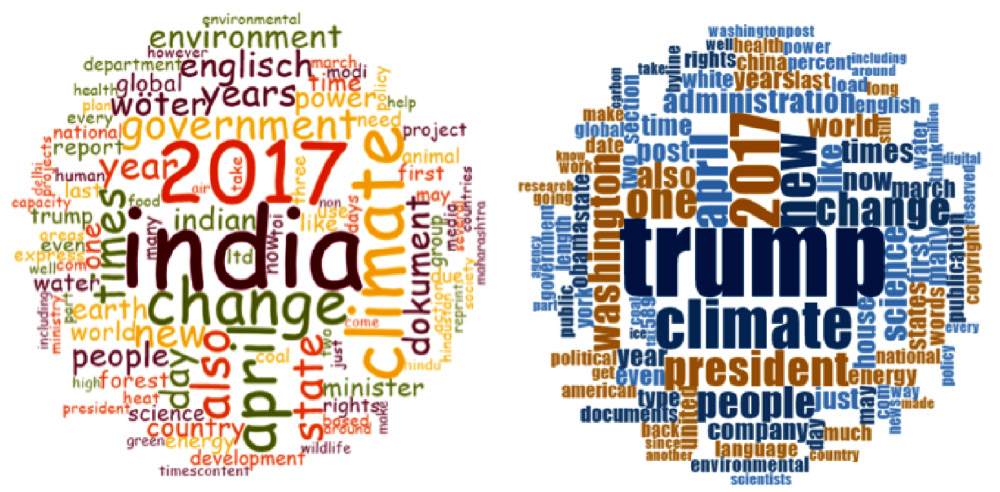Monthly Summaries
Issue 4, April 2017
[DOI]
April 2017 coverage of climate change and global warming decreased compared to the previous month, as coverage across all sources in twenty-eight countries showed an approximate 7% decrease compared to March 2017. Coverage of political, scientific, ecological/meteorological, and cultural dimensions of climate change decreased most prominently in Oceania, which saw more than a 20% decrease compared to the previous month. Asia, Europe, the Middle East, North America and South America all saw modest month-to-month decreases in coverage, while Africa (140%) was the only region to increase its coverage of climate change compared to March 2017. Overall, coverage across all sources in twenty-eight countries decreased approximately 25% compared to April 2016.

Word frequency in climate change and global warming coverage in April 2017 from four Indian newspapers (left) and five US newspapers (right). For India: The Indian Express, The Hindu, the Hindustan Times, and The Times of India. For US: The Washington Post, The Wall Street Journal, The New York Times, USA Today, and the Los Angeles Times.
Despite an overall decrease in coverage, political themes in April 2017 focused on the Trump Administration's dispositions towards the Paris Climate Agreement. Coral Davenport of The New York Times reported that Mr. Trump intends to make a decision before the Group of Seven (G7) meeting in May 2017 on whether or not the US will follow through with its commitments under the Agreement. Ms. Davenport suggested that Mr. Trump's policy advisors are urging him to keep the US committed, while Chris Mooney and Brady Dennis at The Washington Post reported on U.S. Environmental Protection Agency (EPA) Chief Scott Pruitt's recent comments suggesting the U.S. should withdraw from the Paris Climate Agreement. Both articles highlighted the uncertainty surrounding the US President's forthcoming decision and the conflicting advice coming from different parties within the Administration.
Coverage of scientific and ecological dimensions of climate change in April 2017 centered on a number of new and recurrent reports of environmental degradation attributed to global climate change. As examples, several articles (see The Guardian and The New York Times) highlighted the recent and drastic changes to the Slims River in Northern Canada, which lost its water source to another nearby river during a period of intense melting affecting one of Canada's largest glaciers. Jeremy Hance of The Guardian also summarized three recent academic studies that describe and document the negative impacts of climate change on Earth's ecological processes and living organisms.
Spanning the boundaries of cultural, scientific, and political dimensions of climate change, both the 'March for Science' and the 'People's Climate March' garnered significant coverage in April 2017. The 'March for Science' included a large demonstration in Washington D.C., but similar protests took place in hundreds of cities across the U.S. and around the world (see The New York Times). The Bangkok Post reported that Australia, New Zealand, and Germany also saw large turnouts as part of the 'March for Science'. Another article in The Hindu by D. Balasubramanian described the important role of science and technology in India's continued development and called for similar marches in India to support rational, evidence-based decision making.
Coverage also focused on the 'People's Climate March', which took place April 29th, 2017. While the 'People's Climate March' differed in topics, strategies and scope compared to the 'March for Science', there was some undeniable overlap between the two events (see The Washington Post). Nonetheless, each event garnered significant coverage in April 2017 that further underscored the dimensional intersections of science, culture and politics.
